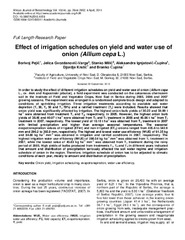Приказ основних података о документу
Effect of irrigation schedules on yield and water use of onion (Allium cepa L.)
| dc.creator | Pejić, Borivoj | |
| dc.creator | Gvozdanović-Varga, Jelica | |
| dc.creator | Milić, Stanko | |
| dc.creator | Ignjatović-Ćupina, Aleksandra | |
| dc.creator | Krstić, Đorđe | |
| dc.creator | Ćupina, Branko | |
| dc.date.accessioned | 2021-04-26T18:52:46Z | |
| dc.date.available | 2021-04-26T18:52:46Z | |
| dc.date.issued | 2011 | |
| dc.identifier.issn | 1684-5315 | |
| dc.identifier.uri | http://fiver.ifvcns.rs/handle/123456789/1043 | |
| dc.description.abstract | In order to study the effect of different irrigation schedules on yield and water use of onion (Allium cepa L., cv. Alek and Kupusinski jabucar), a field experiment was conducted on the calcareous chernozem soil in the Institute of Field and Vegetable Crops, Novi Sad in Serbia during 2005, 2006 and 2007 growing seasons. The experiment was arranged in a randomized complete block design and adapted to conditions of sprinkling irrigation. Three irrigation treatments according to available soil water depletion (T-1 30, T 2 50 and T-3 70%) and a rainfed treatment (T-0) were included. Results showed that onion yield was significantly affected by irrigation. The highest onion bulb yields of 30.22 and 34.99 t ha(-1) were obtained from treatment T-1 and T-3, respectively, in 2005. However, the highest onion bulb yields of 38.46 and 40.07 t ha(-1) were obtained from T-2 and T-3 treatment in 2006 and 40.96 t ha(-1) from T-1 treatment in 2007, respectively. The lowest yield of 10.10 t ha(-1) was obtained from T-0 treatment in 2007 with limited precipitation and higher than average seasonal temperatures. The seasonal evapotranspiration values of irrigated (ETirr) and non irrigated (ETO) onions ranged from 435.6 to 542.9 mm and 290.2 to 393.9 mm, respectively. The highest and lowest water use efficiency (WUE) of 91.35 kg and 34.80 kg ha(-1) mm(-1) was obtained in irrigation and rainfed conditions in 2007, respectively. The highest irrigation water use efficiency (IWUE) of 280.54 kg ha(-1) mm(-1) was obtained from T-1 treatment in 2007, while the lowest value of 45.83 kg ha(-1) mm(-1) was obtained from T-1 treatment during the rainy period of 2005. High yields of bulbs produced from treatments T-1, T-2 and T-3 in different years indicated that amount and distribution of precipitation seriously affected the soil water regime and irrigation schedule of onion in the region. Therefore, irrigation schedule of onion has to be adjusted to climatic conditions of each year, mostly to amount and distribution of precipitation. | en |
| dc.publisher | Academic Journals | |
| dc.rights | openAccess | |
| dc.source | African Journal of Biotechnology | |
| dc.subject | Onion yield | en |
| dc.subject | irrigation scheduling | en |
| dc.subject | evapotranspiration | en |
| dc.subject | water use efficiency | en |
| dc.title | Effect of irrigation schedules on yield and water use of onion (Allium cepa L.) | en |
| dc.type | article | |
| dc.rights.license | ARR | |
| dc.citation.epage | 2652 | |
| dc.citation.issue | 14 | |
| dc.citation.other | 10(14): 2644-2652 | |
| dc.citation.rank | M23 | |
| dc.citation.spage | 2644 | |
| dc.citation.volume | 10 | |
| dc.identifier.doi | 10.5897/ajb10.1059 | |
| dc.identifier.fulltext | http://fiver.ifvcns.rs/bitstream/id/29/1040.pdf | |
| dc.identifier.scopus | 2-s2.0-79954543388 | |
| dc.identifier.wos | 000290096600011 | |
| dc.type.version | publishedVersion |


